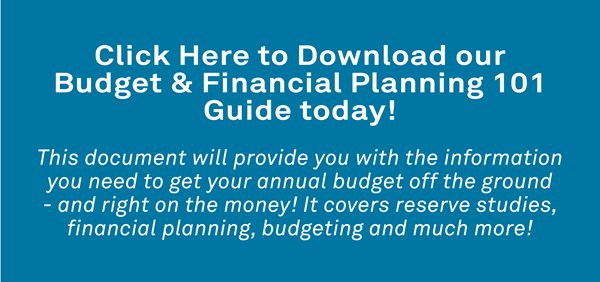It’s that time of the year again, time to start drafting your association’s 2017 budget.
As every association board member knows, a community budget is not an easy thing to tackle. Fortunately, there are some steps you can take to make the process as painless as possible. Here they are:
1. Hold a strategic planning session.
Get your board and association management team together to make sure everyone has an aligned vision when it comes to the future of your community. If possible, it’s great to include an auditor, attorney and insurance agent as well. Set priorities for the coming year, and pin down your level of commitment to each one.
2. Assemble a task force.
Coordinating and communicating between the board and your association management company should be the purview of your ad hoc planning task force. Ideally, this task force will consist of the manager, president, treasurer, and the chairs of your finance and budget committees. This is probably the best starting point as the group that will plan and run your strategic planning session.
3. Do a reserve study.
You’re probably looking at a three- to five-year plan, which is the perfect timeline for planning scheduled replacements of reserve items and ongoing preventive maintenance programs. Factoring these elements into your budget now help eliminate difficult decisions later.
4. Set goals.
Where does your community want to be in three to five years? What things should be changed? What things should be kept the same and just need to be better protected? These are the questions that you should answer before budgeting begins. To do so, consider issuing an owner survey. Another fruitful way to gather this data is through committee input.
5. Conduct tax planning.
If any of your upcoming projects will have tax implications (look specifically to those that generate revenue), then make a plan for it now. A major reserve expenditure will affect your taxes as well, so make sure your accountant or auditor is able to be part of the planning process.
6. Project revenue.
Take a look at all of your revenue streams, especially investments. The income generated by those investments can be applied to your reserves or your operations and should be budgeted accordingly. The avenue you choose depends on your association, but either way, make sure you’re accounting for the next three to five years.
7. Watch for trends.
Now’s the time to look at key areas of your operations and their historical costs and benefits. Talk to your utilities and service contract providers about anticipated increases and decreases. Explore ways to lower costs through technology (such as energy efficient appliances and the like). Consider what community improvements might be on the horizon. And take a close look at payroll and its projected changes over the next three to five years – healthcare costs, specifically, can have a significant impact on your bottom line.
8. Look to the past.
Analyzing past balance sheets and financial statements will help you determine what may lie ahead. To get more out of this part of the process, compare your actual costs to what was previously budgeted. This can help you avoid costly oversights or miscalculations in your upcoming budget. To assess your full financial stability, look to unit owner delinquencies (they should be held at 3-5%), excess operating funds (they should equal 10-20% of annual assessments) and adequate cash reserves. It will help if the past association board has left detailed rationales for their expenditures. If they haven’t done so, it’s time for you to begin.
9. Develop the budget.
You’ll do this by analyzing past data, projecting what you’ll need in the future, and getting real cost data from your current contractors and vendors. Your long-term budget should include categories such as: income (or revenues), which includes assessments and interest from investments; administration, which includes the cost of consulting, management and audits, along with bank charges and computer services; services or contracts, which includes costs from recreation, landscape and maintenance vendors; property protection, which encompasses preventive maintenance and repairs whose costs are spread out evenly over time; and lastly, utilities and capital reserves.
There’s no reason to put off your 2017 budget. Just remember – you’re not planning for the next year, you’re planning for the long-term quality and longevity of your community.

Previous Article Table of Contents